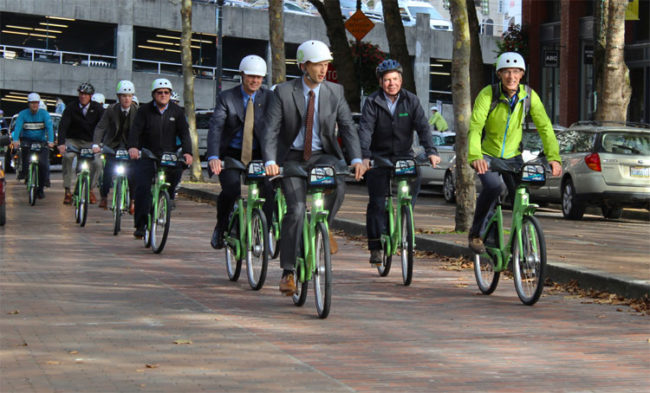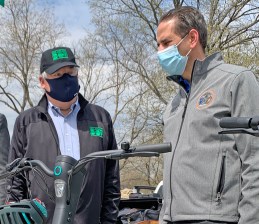SURPRISE! Federal Panel Seeks Mandatory Helmet Laws

A federal safety board issued a surprise recommendation for mandatory bike helmet laws in all 50 states — unanimously approving a last-minute resolution that had not been recommended by the board’s own staff.
The National Transportation Safety Board voted 3-0 to recommend helmet laws even as staff members reminded panelists that such laws may reduce overall cycling, and lead to the “unintended consequence” of more road fatalities because fewer cyclists will mean less pressure on local officials to build the kind of protected infrastructure that is proven to improve cyclist safety.
The measure was not part of a set of recommendations that NTSB staff had drawn up for Tuesday’s meeting — those were approved without much discussion and included only a call for a national discussion of helmet laws. But board member Jennifer Homendy, who described herself as a regular cyclist who is “passionate” about safety, submitted the last-minute additional recommendation, citing the NTSB staff research that found helmet use reduces fatalities and injuries better than any single thing a cyclist can do.
“In an agency focused on safety [how are we] missing a recommendation for helmet laws?” she asked. “We have 16 pages in the report [saying] the most effective method for a bicyclist to mitigate head injury is to properly wear a helmet and that head injury is the leading cause of bicycle-related deaths and that bicycles involved in crashes with motor vehicles sustain a higher proportion of head injuries.”

The staff report indeed said that helmet use reduces the likelihood of injuries by 48 percent, reduces serious injuries by 60 percent and reduces traumatic injuries by 53 percent. But staff analyst Dr. Ivan Cheung had also testified that helmet use often discourages cycling, prompting him to refer to the “unintended consequences” of mandating their use.
He was also asked during his part of the presentation why the Netherlands has such a low rate of bike fatalities, especially given the country’s low rate of helmet use and lack of mandatory helmet law. Cheung made it clear — as did his report — that the real way to protect cyclists is to make roadways safer and to reduce speed limits on drivers rather than worrying so much about cyclist behavior.
“The Netherlands has been committed to making bicyclists part of their complete street and part of the overall transportation strategy — and they have tens of thousands of protected bike lanes and protected intersections,” he said. “Not to shame the U.S., but we are 20 or 30 years behind. As a result, bicycling as a percentage of the mode share is very very high. … Our team thinks helmets are important, but the difference between the Netherlands and the U.S. is infrastructure.”

In his presentation, for example, Cheung and his fellow analysts highlighted the main reason that cyclists are dying in increasing numbers on American roadways – up from 806 in 2017 to 857 last year, up 6.3 percent even as overall road fatalities were down 2.5 percent. Bike fatality rates have risen steadily since 2009 (as have pedestrian fatalities), even as the safety of occupants of cars themselves has increased.
“Roadway infrastructure is effective, but under-utilized,” he said, adding that only four states have added protected bike lanes to state roadways. “Speed and speeding are important issues facing vulnerable road users. Road diets improve safety by reducing total crashes from 19-46 percent.”
He focused his presentation on road design because the single biggest cause of cyclist deaths in a three-year study period of 2014-2016 was a motorist hitting a cyclist in a mid-block part of a roadway — a type of crash that is virtually eliminated by a protected bike lane. Crashes at intersections are also quite common, Cheung said, but speeds tend to be lower at intersections, reducing the likelihood of fatalities.
Cyclists are also 65 percent more likely to die on roads with 30-35 mph posted speed limits compared to 25 mph or less, Cheung added.
But Cheung also reiterated the cyclists should also wear helmets, saying that 62 percent of bike-related fatalities were from head injuries and there were 541,000 head injuries to cyclists overall between 2014 and 2017.
“The most-effective way to reduce head injuries is by wearing a helmet,” he said.
Homendy applauded all of Cheung and his team’s findings, but focused her questioning solely on pushing the panel to insist on mandatory helmet laws — using the NTSB’s history of being the first agency to advocate for seatbelt laws as her model.
“I understand there are concerns in the bicycle community that this could reduce the number of bicyclists,” she said, “but the NTSB’s mission is not about bicycle use. Our mission is safety. It’s the National Transportation Safety Board. Our goal is zero deaths. The way we go about doing that is by issuing recommendations that prevent crashes, that prevent injuries and that save lives. … We know the dangers of not wearing a seatbelt and the NTSB issued recommendations on seatbelt use. … That’s the power of the NTSB. We set the safety bar.”
Her impassioned call snuffed out any real debate by her fellow panelists, Chairman Robert Sumwalt and Vice-Chairman Bruce Landsberg.
After the hearing, bike advocates were livid.
“At one point, Sumwalt said, ‘In the event that a bicycle crash cannot be prevented, we know that the best possible protection for a bicyclist is always wearing a helmet,’ but that conclusion is untrue,” said lawyer Steve Vaccaro, who works exclusively with victims of road violence. “To label crashes as inevitable is to accept some level of traffic violence as the norm. NTSB should adopt Vision Zero as its policy instead, and make meaningful policy recommendations aimed at ending traffic violence, rather than leaving cyclists to armor themselves against essentially unregulated drivers.
“Why doesn’t the NTSB set maximum speed capacities for vehicles to prevent them from traveling faster than posted speed limits?” Vaccaro added. “It’s technologically feasible and guaranteed to save thousands of lives a year. Instead, NTSB apparently has no problem with the fact that virtually every motor vehicle marketed in the U.S. can exceed 100 miles per hour.”
Jon Orcutt of Bike New York also took exception to the NTSB — and the general inadequacy of federal response to the steady rise in pedestrian and cyclists’ deaths since 2009.
“In a country where tens of thousands of people die on the roads each year, no one should listen to anything said by people involved in national road safety institutions,” said Orcutt, a former New York City Department of Transportation official. “Stick to plane crashes if you can’t be bothered with some basic research on how bike transportation has succeeded or failed around the world.”
Federal road safety establishment failed long ago. It needs to be rebuilt from scratch https://t.co/bP3D7gEW10
— Jon Orcutt (@jonorcutt) November 5, 2019
The NTSB is indeed best known as the agency that investigates plane crashes or major train derailments. The hearing and staff report comes as American roadways are awash in a blood tide of cyclist deaths. It’s the first time in nearly 50 years that the agency has looked broadly at cyclists, agency officials said.
Beyond calling on states to adopt helmet laws, the board also approved 11 recommendations, including:
- Recommending to federal researchers that current research efforts on vehicle safety systems include bicyclists and other vulnerable road users.
- Recommending to the National Highway Traffic Safety Administration that new car crash studies include an assessment of how well the car avoids crashes with bicyclists — which is currently part of Europe’s crash-test regime.
- Recommending to the Federal Highway Administration that separated bike lanes and intersection safety treatments be placed on the list of proven safety countermeasures, which, oddly, they are not currently.
- Recommending to the Consumer Product Safety Commission that it finally update its requirements — last updated in 1980 to require mandatory installation of reflectors on new bikes — to evaluate how new technologies, such as LED lights, could be incorporated into new bike models.
Clearly the agency is interested in at least talking about road carnage. It is unclear how seriously other agencies are acting. Included in the NTSB recommendations were 10 recommendations that it had already made to the Federal Highway Safety Administration, including calls for visibility systems to compensate for blind spots in large trucks, requiring vehicle connectivity technology, better testing of forward collision avoidance systems, and mandating better “adaptive” headlight systems such as those used in Europe.
Cheung said the safety administration has also yet to move on another earlier recommendation from the NTSB: changing a controversial “85th percentile rule” that actually encourages states to raise speed limits rather than lower them.
“The next step is for the FHWA to act on it,” Cheung said. “Our recommendations are pushing for a different philosophy of how speed limits are set.”
At that moment, a telling exchange occurred between Homendy and Cheung, with Homendy asking out of the blue, “What is the leading cause of bicyclist deaths?”
Cheung replied, “Motor vehicle crashes,” seemingly surprising Homendy, who followed up by reiterating her belief that helmet laws are essential.
Ironically, Homendy clearly wanted to present herself as an advocate for cyclists, at one point asking Cheung if his safety data analyzed the role played by drivers who block bike lanes, “forcing bicyclists out into traffic where they can get hit.”
Alas, the National Transportation Safety Board staff, which has the benefit of “black boxes” on airplanes that can pinpoint virtually every system on a plane, plus radar and other technology, has no idea how many cyclists are being killed by anyone but the driver who hit them because NTSB research on roadways relies entirely on locally gathered crash reports, typically compiled in a suboptimal manner by police departments.
“Blocked bike lanes is a known issue,” Cheung said. “It’s not just annoying, it’s a safety issue. But if a truck blocked a bike lane, even if it caused a crash, you won’t see that in the reports because they focus on vehicles in the crash. I asked the law enforcement community if they keep track of those situations and was told they don’t.”



